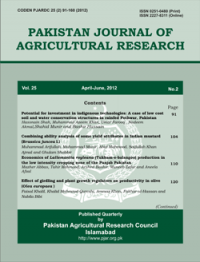INFLUENCE OF THREE CONSTANT AND TWO RHYTHMICALLY FLUCTUATING TEMPERATURE REGIMES ON THE LIFE-TABLE PARAMETERS OF BROWN LACEWING SYMPHEROBIUS FALLAX
Waseem Ahmad Gillani* and Mike Copland**
ABSTRACT
Brown lacewing (Sympherobius fallax), characterized by good adult longevity, high fecundity, and fast development rates are important predators in many agricultural systems. Life tables of S. fallax were constructed at 20°C, 24°C, 28°C and rhythmically fluctuating temperature regimes from 16°C to 24°C and 24°C to 32°C. Studies were carried out describing survival, reproduction and development of S fallax. Survival was positively temperature dependent. Sex ratio was not affected by constant temperatures from 20 to 28°C; however this ratio was affected by rhythmically fluctuating temperatures. The female proportion increased in 24°-32°C regimes. The development could not take place at 16°C and 32°C constant temperatures. But in rhythmically fluctuating temperature regimes development of stages took place.
To share on other social networks, click on any share button. What are these?







